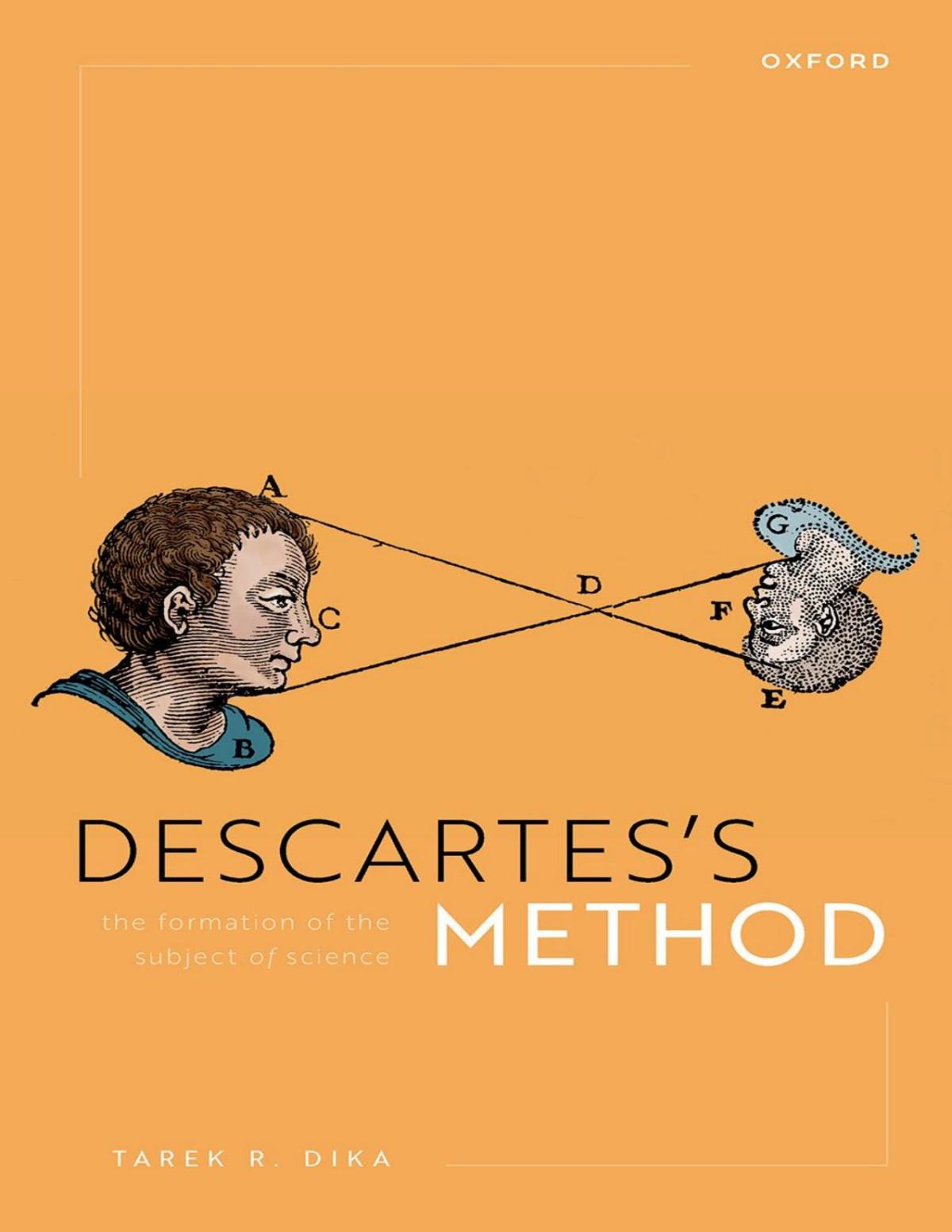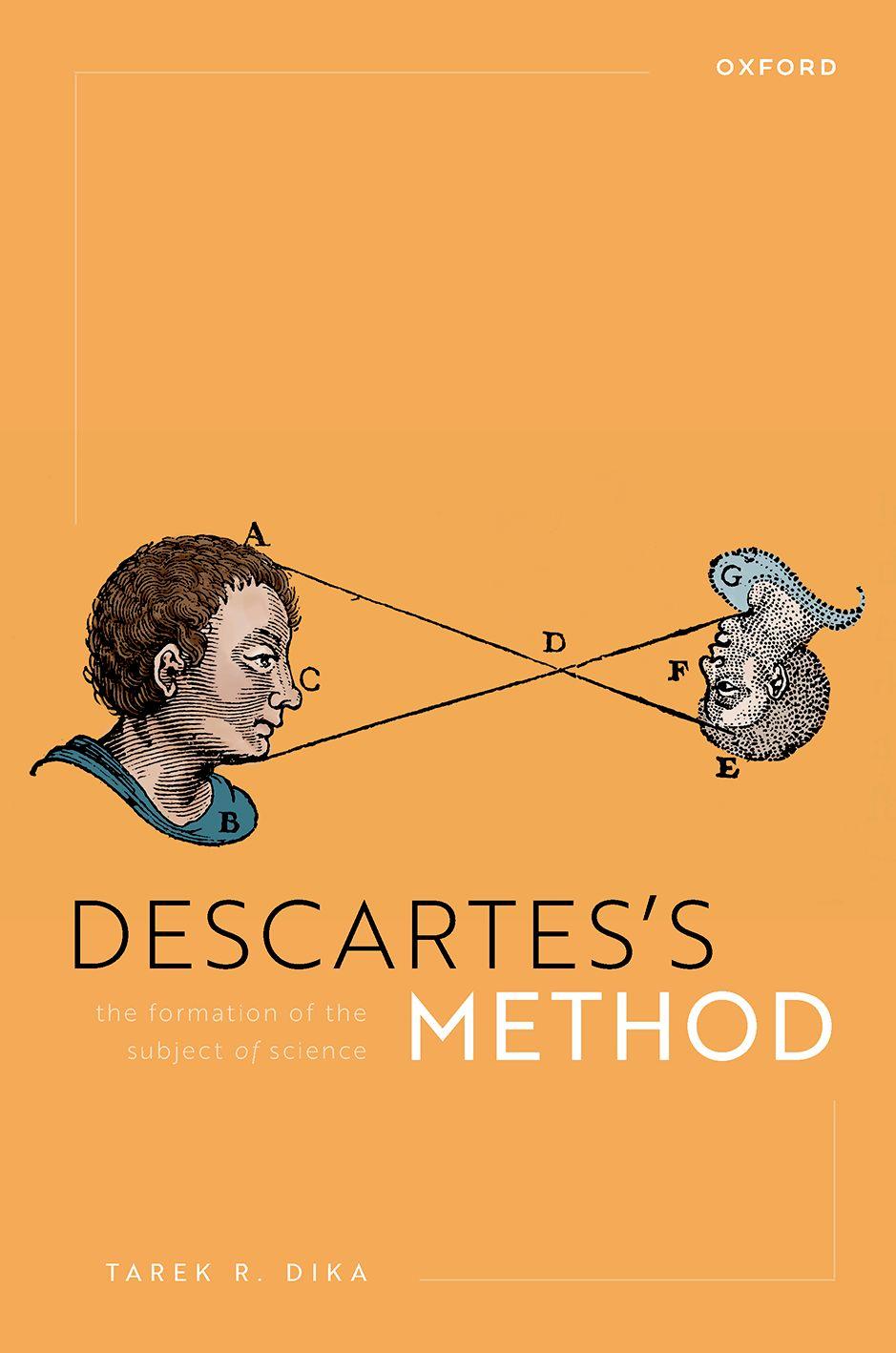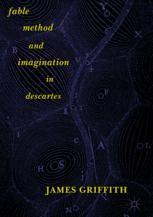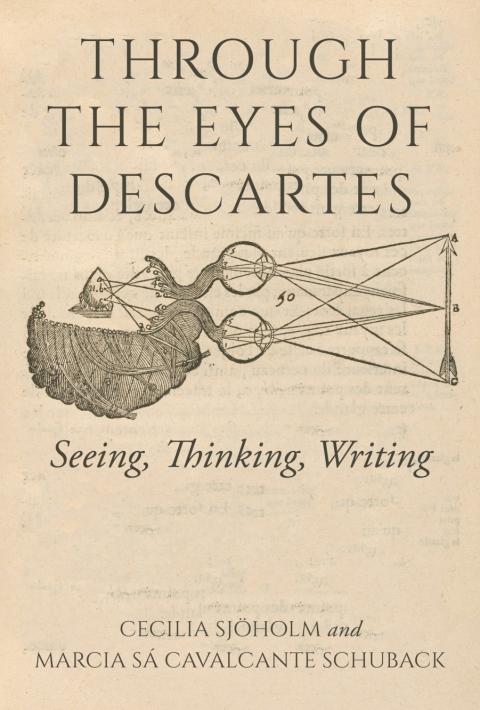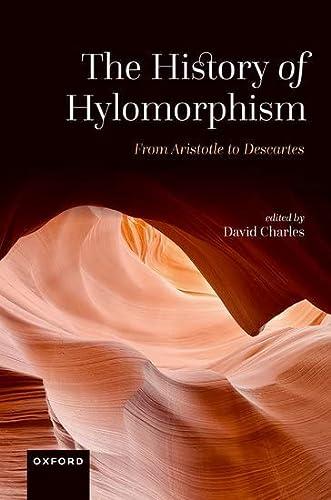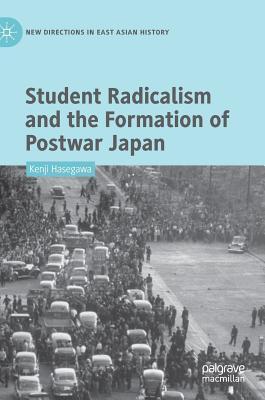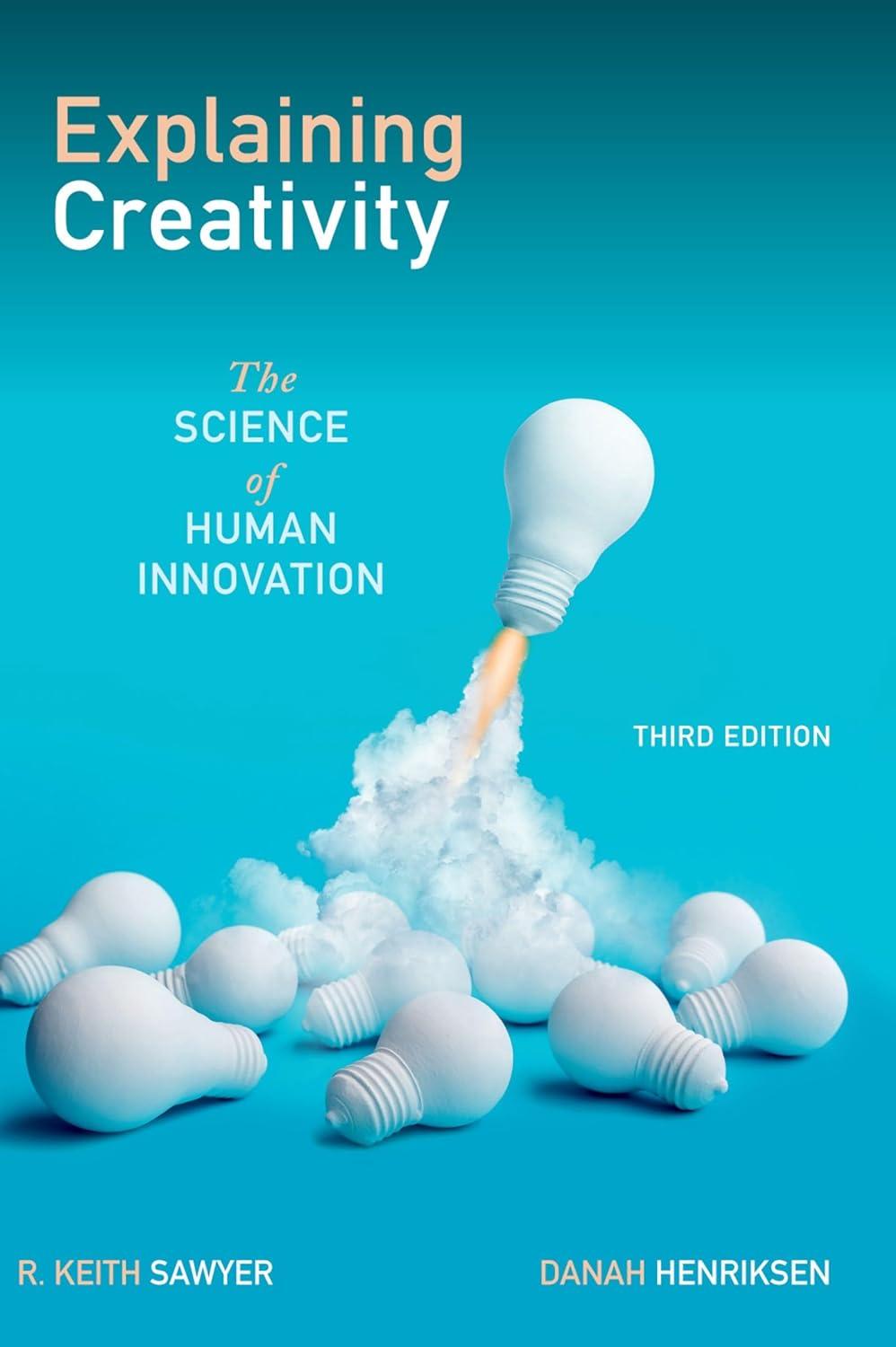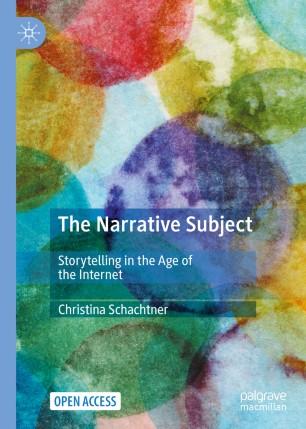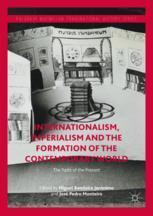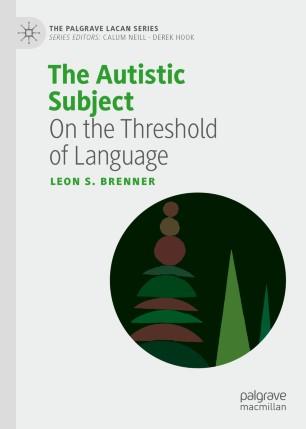Descartes’s Method
The Formation of the Subject of Science
TAREK R.
DIKA
Great Clarendon Street, Oxford, ��2 6��, United Kingdom
Oxford University Press is a department of the University of Oxford. It furthers the University’s objective of excellence in research, scholarship, and education by publishing worldwide. Oxford is a registered trade mark of Oxford University Press in the UK and in certain other countries
© Tarek R. Dika 2023
The moral rights of the author have been asserted
First Edition published in 2023
All rights reserved. No part of this publication may be reproduced, stored in a retrieval system, or transmitted, in any form or by any means, without the prior permission in writing of Oxford University Press, or as expressly permitted by law, by licence or under terms agreed with the appropriate reprographics rights organization. Enquiries concerning reproduction outside the scope of the above should be sent to the Rights Department, Oxford University Press, at the address above
You must not circulate this work in any other form and you must impose this same condition on any acquirer
Published in the United States of America by Oxford University Press 198 Madison Avenue, New York, NY 10016, United States of America
British Library Cataloguing in Publication Data Data available
Library of Congress Control Number: 2022941376
ISBN 978–0–19–286986–9
ebook ISBN 978–0–19–269694–6
DOI: 10.1093/oso/9780192869869.001.0001
Printed and bound in the UK by TJ Books Limited
Links to third party websites are provided by Oxford in good faith and for information only Oxford disclaims any responsibility for the materials contained in any third party website referenced in this work.
For my loving parents, Amira and Rifaat Dika, My wife, Constance, and our beautiful daughter, Saba
C’est à nous de procurer par nos propres efforts cette perfection de l’ingenium que nous invite la Méthode Cartésienne. Là est sa véritable signification et son véritable prix. Et c’est pourquoi Descartes proteste qu’elle consiste “plus en pratique qu’en théorie ” Lorsqu’il nous parle de “bien conduire notre raison,” il ne croit ni souhaitable ni possible de nous révéler des chemins tout tracés qu’il suffirait de suivre pour arriver infailliblement et comme automatiquement au but Il nous recommande de “former” notre esprit au contact des choses, de le “nourrir de vérités,” de le cultiver en l’exerçant Il a en vue, non pas “une clef de l’art d’inventer,” mais une éducation et, pour ainsi dire, un “dressage” de notre faculté inventive. Autrement dit, la méthode de Descartes, c’est un ensemble d’habitudes à prendre par chacun de nous, à l’exemple de Descartes, d’après des moyens analogues à ceux dont il a personnellement ressenti l’efficacité. […] Et c’est l’habitude, ou plutôt l’ensemble d’habitudes ainsi prises, c’est cela, et non pas une liste de formules rigides machinalement applicables, qui fait l’essence de la méthode cartésienne.
Jean Laporte
Contents
Acknowledgments
Preface
Abbreviations
English translations
Introduction: Descartes’s Method: Universality without Uniformity
PART I THE HABITUAL UNITY OF SCIENCE: AQUINAS TO DESCARTES
1.
The Habitual Unity of Individual Sciences: Aquinas to Suárez
Hexis/Habitus
Aristotle’s Ban on Genus-Crossing (μετάβασις) in Posterior Analytics I.7
Aquinas’s Habitual Interpretation of the Unity of Science
The Ontology of Scientific Habitus: Simple Quality or Complex Order?
4 2
4 3
Aquinas’s Gradient Ontology of Scientific Habitus
Scotus’s Virtual Containment Ontology of Scientific Habitus
Ockham’s Aggregate Ontology of Scientific Habitus
Suárez’s Pluralist Ontology of Scientific Habitus
Genus-Crossing and Subalternation
2.
The Habitual Unity of Science: Descartes
The Cartesian Scientific Habitus: Basic Properties
The Subject, Acquisition, and Ontology of the Cartesian Scientific Habitus
Suspending Aristotle’s Ban on Genus-Crossing
Supertranscendental Extrinsic Denomination: The Simple Natures
The Unity of Science in Rules
Rule 1 in the Cambridge Manuscript
PART II THE OPERATIONS AND CULTURE OF THE METHOD
The Operations of the Method: Intuition, Deduction, and Enumeration
The Principle of Proportionality
Facie ad faciem: Intuition
Descartes’s Interlocutors in the Definition of Intuition in Rule 3
Illatio: Deduction
Enumeratio, sive inductio: Enumeration
Enumeration1: Reduction and Order
Clarity and Distinctness in Problems: Relevant and Irrelevant Conditions
Enumeration2: Irreducibly Complex Linear and Non-Linear
Inference and the Expansion of Intuition
Sufficient, Complete, and Distinct Enumeration3: Inference and Class Construction
Problems: Definition and Taxonomy
Perspicacity and Sagacity: Two Intellectual Virtues or Habitus
The Order of Operations
The Culture of the Method: The Methodological Function of Mathesis Universalis
Mathesis Universalis: The Second Degree of the Cartesian Scientific Habitus
The Science of Order and Measure
First Lesson: The Theory of Order in Rule 6
Second Lesson: Direct and Indirect Deductions
From Recreational Mathematics to Mathesis Universalis
Mathesis Universalis and the Unity of Mathematics in Rules 13–21
Mathesis Universalis, Cartesian Mathematics, and Method
Mathesis Universalis and the Cambridge Manuscript
From Mathesis Universalis to the Problem of the Limits of Knowledge
PART III THE FIRST PROBLEM OF THE METHOD: THE “NOBLEST EXAMPLE”
Defining the Problem of the Limits of Knowledge in Rules
The Noblest Example: Three Problems
The “Method of Enumeration”
Sufficient Enumeration2, Supposition, and Truth in Rule 12
Two Concepts of Epistemic Limit in Rule 8
Descartes’s Theory of the Faculties in Rules
Mechanism, Habitus, and the Limits of Knowledge in Rules
Sensation and Figure
From Figure to Representation: The Common Sense, the Phantasy, and the Passivity of Vis Cognoscens
The Activity of Vis Cognoscens and Descartes’s Habitual Theory of the Faculties in Rules
Descartes’s Theory of the Objects of Knowledge in Rules
The Simple Natures
The Enumerative Criteria: Cognitive Indivisibility, SelfEvidence, and Univocity
The Intellectual Simple Natures and the Use of the Pure Intellect
The Material Simple Natures and the Use of the Intellect and the Imagination
Epistemic Transcendentals: The Common Simple Natures
Negations, Privations, and the Compositionality of Thought
The Theory of Conjunction: Descartes’s First Theory of Distinctions
Complexity and Confusion: Permissible and Impermissible Varieties
Intuition and Judgment
Judgment, Composition, and Error
Descartes’s Conclusions
The Theory of Simple Natures: Neither Realism Nor Idealism
The Origins of Cartesian Dualism in Rule 12 New Evidence, Old Problem
Descartes’s Dualism in RulesAT Dualism in RulesCM
PART IV APPLICATIONS: PERFECTLY AND IMPERFECTLY UNDERSTOOD PROBLEMS
Perfectly Understood Problems: Method and Mathematics in Rules 13–21
The Cartesian Scientific Habitus in Mathematics
The Unity of Discrete and Continuous Magnitude in the Imagination
Abstracting Problems from Particular Subject-Matters
The Unit
Symbolic Intuition? Algebraic Notation in Rules
The Geometrical Calculus
The Problem of Root Extraction
The Collapse of Descartes’s Methodological Enterprise in Rules
Imperfectly Understood Problems: Descartes’s Deduction of the Law of Refraction and the Shape of the Anaclastic Lens in Rule 8
Neither “Mixed Mathematics” nor “Physico-Mathematics”
Problems in Previous Reconstructions
From Imperfectly Understood Problems to Perfectly Understood Problems: Enumeration1
What is a Natural Power (Potentia Naturalis)? Descartes’s Pre-Metaphysical Physics
The Action of Light
How Light Passes through Transparent Media
Deducing the Law of Refraction
Deducing the Anaclastic Order of Research and Order of Exposition
PART V BEYOND RULES
Descartes’s Method after Rules Method or Methods? From Rules to Discourse The Turn to Metaphysics Method and System after Rules
Simple Natures and Simple/Primitive Notions after Rules
Simple Natures and Descartes’s Ontology of Substance, Attribute, and Mode
Conclusion: Reassessing the Meaning of Method in Descartes Appendix: Descartes’s Rules: Manuscripts, Dates, and Title(s)
Bibliography Index
Acknowledgments
It took me nearly ten years to write this book. A combination of naiveté and enthusiasm blinded me to how demanding it would be. But I am happy to have written it, and even happier to thank the individuals and institutions who supported me along the winding road to completion.
The research for this book was conducted at the Johns Hopkins University, the University of Michigan, and the University of Notre Dame. A three-year postdoctoral fellowship at the University of Michigan Society of Fellows permitted me to delve into the history of scholastic debates about the unity of science and identify the principles behind the interpretation of Descartes’s method offered in this book.
Further support from the University of Notre Dame’s Institute for Scholarship in the Liberal Arts (ISLA) enabled me to travel to Paris for an international conference on the Cambridge manuscript organized by Daniel Garber at the Institut d’études avancées de Paris in 2018. I am grateful to these institutions for their support.
At Johns Hopkins, I would like to thank Hent de Vries (now at NYU), whose mentorship and support over a period now spanning more than fifteen years I will never be able to repay. I would also like to thank Eckart Förster, Michael Fried, Ruth Leys, Paola Marrati, Yitzhak Melamed, Marva Philip, Michael Williams, and Meredith Williams. The education I received at Johns Hopkins remains second to none.
At Michigan, I would like to thank Tad Schmaltz, who met with me every other week for three years, read and helped me improve my papers, and introduced me to the wider world of scholars in early modern philosophy. I could not have hoped for a better mentor. I
would also like to thank the organizers and participants of the University of Michigan’s Premodern Colloquium, especially Tom Willette and Helmut Puff, for inviting me to present my research and receive valuable feedback. Finally, I would like to thank my colleagues and friends whose support made an enormous difference to both my life and my career, including Elizabeth Anderson, Alina Clej, Ed Curley, S.E. Kile, Louis Loeb, Monu Lahiri, Don Lopez, Tomoko Masuzawa, Keith Mitnick, Yasmin Moll, Jennifer Nelson, Yopie Prins, Laura Reutsche, Mireille Roddier, Scott Selberg, Anton Shammas, Jamie Tappenden, Linda Turner, Silke Maria-Weineck, and Damon Young.
At Notre Dame, I would like to thank my colleagues and friends in the Program of Liberal Studies, the Program in History and Philosophy of Science, and the Department of Philosophy, including Francesca Bordogna, Katie Bugyis, Eric Bugyis, Chris Chowrimootoo, Therese Corey, Steve Fallon, Anna Geltzer, Robert Goulding, Debbie Kabzinski and Becky Badger, Katharina Kraus, Julia Marvin, Felicitas Munzel, Jenny Martin, Sam Newlands, Emma Planinc, Clark Power, Andrew Radde-Gallwitz, Gretchen ReydamsSchils, Denis Robichaud, Joseph Rosenberg, Even Ragland, Fred Rush, Phil Sloan, Tom Stapleford, Henry Weinfield, and Steve Watson. I would also like to thank Hussein Abdulsater, Corey Garibaldi, David Hooker, Leonardo Francalari, Chante Mouton Kinyan, Sara Marcus, Ebrahim Moosa, Azareen Van der Vliet Oloomi, Viveca Pattison Robichaud, Roy Scranton, Yasmin Solomonescu, and Aldo Tagliabue. I wrote the bulk of this manuscript while at Notre Dame, and without the support of my friends and colleagues, I would not have been able to get through it.
At Toronto, I would like to thank my colleagues in the Department of Philosophy, including Donald Ainslie, Rebecca Comay, Robert Gibbs, Mark Kingwell, Willi Goetschel, William Paris, Martin Pickavé, Michael Rosenthal, Marleen Rozemond, Nick Stang, Trevor Teitel, and Owen Ware.
In Paris, I owe a special thanks to Denis Kambouchner, whom I met in Summer 2014 and who has been a mentor and very close friend ever since. This book bears the mark of Denis’s influence in more ways than I can enumerate here. I would also like to thank
Frédéric de Buzon for his incredibly helpful comments on Chapter 10, David Rabouin for helping me navigate my way through the complexities of Descartes’s mathematics, and Jean-Luc Marion and Vincent Carraud for inviting me to participate in the events organized by the Centre d’études cartésiennes.
In Australia, I would like to thank John Schuster, who read and criticized previous drafts of Chapter 10, but not without invaluable suggestions on how the chapter might be improved, despite his disagreements.
In Cambridge, I would like to thank Richard Serjeanston, who met with me in October 2017, walked me over to the library, showed me a copy of the Cambridge manuscript, and even provided me with a guided philological tour of the manuscript. Very few people had seen the manuscript in the flesh at this point, and I hope that my publications since have proven that nothing can replace the painstaking labor Richard and Michael Edwards have devoted to the manuscript.
I would like to thank Peter Dear, Robert Goulding, Denis Kambouchner, Sam Newlands, and Tad Schmaltz for their participation in a book manuscript workshop held at the University of Notre Dame on February 18, 2021. The book is in much better shape due in no small part to their comments and criticisms. Many thanks to Tom Stapleford for encouraging me to organize the workshop and to the Program of Liberal Studies for funding it.
I presented parts of this book at various conferences over the years. I would like to thank Patrick Brissey, Gideon Manning, Jack Stetter, and Stephen I. Wagner for their comments at the APA (Pacific and Central Division). John Carriero provided very helpful comments on an early draft of Chapter 8. The Atelier FrancoAméricain de philosophie moderne (organized by Jean-Pascal Anfray, Frédéric de Buzon, Daniel Garber, Denis Kambouchner, Steve Nadler, Sophie Roux, Tad Schmaltz, and held annually in either Ann Arbor, Madison, Paris, or Princeton) provided me with many opportunities to present work in progress, receive comments from some of the finest historians of early modern philosophy, and become a part of an international scholarly community. I hope to return the favor one day by hosting the Atelier here in Toronto.
The two anonymous referees for Oxford University Press provided detailed and critical feedback that greatly improved the book as a whole.
Among those whom I have not yet mentioned, I would like to thank Arash Abazari, Vlad Beronja, Johannes Birke, Andrew Bush, Martijn Bujis, Marco Coco, Sara Elamin, Mohammed Elghoul, Elena Fabietti, Jane Fletcher, Jeroen Gerrits, Elham Hatef, Alexander James, Waleed Jammal, Amy Kraus, Mike Leonard, Greg Piton Saint Martin, Samuel Monsalve, Larry McGrath, Rebecca Pekron, Bican Polat, Avreimi Rot, Aviva Rot, Johannes Schade, Martin Shuster, Nils Schott, Ian Singleton, Natalya Sukhonos, and Joshua Thompson.
I would also like to thank my editor at Oxford, Peter Momtchiloff, with whom I intend to continue working in future, and the entire team at Oxford, who transformed this manuscript from a digitally stored file on my computer into a book available throughout the world.
Parts of Chapters 1 and 2 derive from three articles, “Method, Practice, and the Unity of Scientia in Descartes’s Regulae,” “Extrinsic Denomination and the Origins of Early Modern Metaphysics: The Scholastic Context of Descartes’s Regulae,” and (with Denis Kambouchner) “Descartes’s Method” (forthcoming in The Cartesian Mind, ed. Jorge Secada and Cecilia Wee). I would like to thank the Journal of Early Modern Studies, Springer, and Routledge for permission to draw on material from these three articles. Parts of Chapter 3 derive from my entry, “Descartes’ Method,” and appear here with the generous permission of the Stanford Encyclopedia of Philosophy Chapter 8 is drawn from my article, “The Origins of Cartesian Dualism” (Journal of the American Philosophical Association) and is here reprinted with the generous permission of Cambridge University Press. Chapter 10 is drawn from “Descartes’ Deduction of the Law of Refraction and the Shape of the Anaclastic Lens in Rule 8” (HOPOS: The Journal of the International Society for the History of Philosophy of Science), and is reprinted with the generous permission of Chicago University Press.
Finally, I would like to thank my family: my wife, Constance de Font-Réaulx, who endured my worst anxieties about this book and whose unwavering support continues to get me through my days;
our baby daughter, Saba, who is a miracle; my parents, Amira and Rifaat Dika, who sacrificed everything for us; and my sisters, Sahar and Hala Dika, whom I love dearly.
Toronto September 2022
Preface
In this book, I provide a systematic interpretation of Descartes’s method in his first, posthumously published treatise, Rules for the Direction of the Mind (Regulae ad directionem ingenii) (henceforth Rules), most likely composed during the 1620s, but not published until 1684 (in Dutch translation) and 1701 (in Latin), many years after Descartes’s death in 1650.1 By “systematic” I simply mean that the interpretation is informed by a principle: Descartes’s method is a problem-solving cognitive disposition or habitus that can be actualized in a variety of well-defined ways, depending always on the parameters of the problem at hand. I have aimed to provide an interpretation that, in addition to being systematic, is also as comprehensive as possible: I cover Rules in its entirety as well as a number of important developments in Descartes’s method after Rules (whether I have succeeded is another matter, and is in any case up to the reader to decide).
I have deliberately chosen not to organize the book according to the order of the text, but rather according to the order of problems that must be solved in order to learn the method. Unlike Descartes’s Meditations, where the order of the text reflects the order of problems that must be solved in order to discover the primary notions or principles of metaphysics, in Rules the order of the text does not consistently reflect the order of problems that must be solved in order to learn the method. Descartes’s conception of the treatise matured as he wrote it. The first problem that must be solved by the method—the problem of the limits of knowledge—does not appear until Rule 8, and Descartes discusses it after having discussed a problem that can only be solved once the problem of the limits of knowledge has been solved: the problem of the law of refraction and the shape of the anaclastic lens. The problem of the
law of refraction and the shape of the anaclastic lens, moreover, is what Descartes terms an “imperfectly understood problem,” or a problem in which the conditions relevant to the solution are not known in advance, but must be found. These problems typically arise in natural philosophy, and according to Descartes’s division of the treatise, they belong to the third part (Rules 25–36), which Descartes never completed (Rules ends prematurely at Rule 21). To solve imperfectly understood problems, one must first become proficient in solving what Descartes terms “perfectly understood problems,” or problems in which the conditions relevant to the solution are known in advance. These problems typically arise in mathematics, and according to Descartes’s division of the treatise they belong to the second part (Rules 13–24).
Were I to have organized the book according to the order of the text, I would have had to violate the order of problems that must be solved in order to learn the method, which struck me as inappropriate. Thus, I have organized the book according to Descartes’s division of the treatise into three parts (a division he himself does not consistently respect): operations and simple propositions (Chapters 2–3); the problem of the limits of knowledge (the first problem that must be solved by the method) (Chapters 5–8); perfectly understood problems (Chapter 9); and imperfectly understood problems (Chapter 10). This order, I believe, best exhibits how practice in the method develops in degrees from the simplest problems to more complex problems, up to the point where problems in mathematics and natural philosophy can be solved.
The organization of this book reflects not only an understanding of how Descartes intended his method to be acquired and applied but also an understanding of Rules as a treatise that, despite its imperfections, exhibits underlying unity. My emphasis on the unity of the treatise contrasts sharply with other interpretations, above all that of J.-P Weber in La constitution du texte des Regulae. Weber’s insistence on dating, not only the treatise as a whole or even individual rules but even parts of rules (by both year and month) over a period of nine years has contributed to the perception that Descartes’s Rules is a patchwork, which Descartes failed to “rigorously compose,” and which contains a “mass of contradictions
[…] within a rule […] no less than between rules.” Indeed, Weber continues, “Rules does not reveal one method, but rather many, which succeed one another, perfect one another, or mutually annul one another.” In short, Rules is “allusive, excessively composite and, consequently, by and large contrived.”2 Even when Descartes’s readers disagree with the details of Weber’s chronology, they nevertheless retain his thesis that Rules should be divided, not internally into three parts, according to its own criteria of unity, but rather externally, according to discrete “stages of composition” that are nevertheless incredibly difficult to individuate based on the available evidence.3 When one delves into the details of such interpretations, one invariably finds that the division of Rules into stages of composition is based, as it must be, on the author’s own interpretation of the text. As is well known, Descartes never dated Rules, and none of the manuscript copies indicate when the original manuscript was written. Any dating, proposed by anyone (including myself), is based entirely on interpretations of textual and circumstantial evidence.
There is no doubt that Descartes wrote Rules over a period of many years (how many years is less clear),4 and that, like many other texts in the history of philosophy, real or apparent gaps and discontinuities pose serious challenges for the interpreter. Everything is further complicated by the fact that Descartes never completed Rules. Throughout this book, I take into consideration, whenever appropriate, gaps, discontinues, and developments in Descartes’s position, as exhibited in any one manuscript, in differences between the relevant manuscripts, or between Rules and Descartes’s subsequent texts. However, I do not base my interpretation of Rules on a chronological division of the treatise into stages of composition.5 Instead, I provide an interpretation of Rules based on Descartes’s own principal of unity, which divides the treatise into three parts of twelve rules each, and which is itself based on the order of problems that need to be solved in order to learn the method. This does not mean that I simply ignore chronological considerations. Far from it. It only means my interpretation does not
fundamentally depend on any division of the treatise into chronological stages.
1 See Descartes 1684 and 1701. The consensus (see, e.g., Weber 1964, 109–45, 184–94; Gaukroger 1995, 181, and Schuster 2013, 307–49) is that Descartes abandoned Rules by 1628, but new evidence from the Cambridge manuscript suggests that Descartes may have continued composing Rules after 1628. See Serjeanston and Edwards in Descartes forthcoming. On the manuscripts, title(s), and composition of Rules, see Appendix
2 See Weber 1964, 1–2
3 Weber’s enduring influence on the scholarship on Descartes’s Rules is evident in Garber 1992, Gaukroger 1995; Schuster 1977 and 2013. Gaukroger, for instance, describes himself as “[f]ollowing the general thrust of Weber’s account (but not the details, which are often too fine-grained to bear the evidence) […]” (Gaukroger 1995, 111). Schuster endorses Weber’s thesis that “the Regulae, in fact, were composed in stages between 1619–1628 and that different strata in the text correspond to different stages in the development and reformulation of Descartes’s methodological ideas,” but he also points out that he makes “drastic revisions” whenever necessary (Schuster 2013, 227) Garber 1992, 317, n 1 acknowledges that Weber 1964 is the “standard account of the composition of Rules, ” but while he finds “the basic chronology correct,” he is “a bit skeptical that one can make such fine distinctions ” He relies principally on Weber’s chronology and Schuster’s revisions in Schuster 1980 and 1986
4 For my own view, see the Appendix.
5 Indeed, recent evidence suggests, pace Gaukroger and Schuster, that mathesis universalis forms no part of the earliest stage of composition (as they claim; see references in n 3 above), since it is nowhere to be found in the Cambridge manuscript, which seems to be copied from an earlier draft of Rules For more discussion, see Chapter 4 and the Appendix This is only one example of the risks involved in basing one’s interpretation of Rules on a conjectural chronology.
Descartes
CSM/CSMK
Abbreviations
The Philosophical Writings of Descartes (1985–1991) Cited by volume number and page number “CSM 1:7” = “The Philosophical Writings of Descartes, volume 1, page 7.” “CSMK” is employed for volume 3.
Oeuvres de Descartes (1996). Cited by volume number and page number. “AT 10:3” = “Oeuvres de Descartes, volume 10, page 3.”
Aquinas
Summa theologiae in Opera omnia (1882– and English translation in Aquinas 1945). Cited by year, volume number, and page, followed by part number, question number, and article number. “Aquinas 1891, 6:344 (ST I–II, q. 64, art. 4)” = “Opera omnia, volume 6, page 344 in Summa theologiae, question 64, article 4.”
Scotus
Ord.
Rep.
Quaestiones super libros Metaphysicorum Aristotelis in Opera omnia (1891–1895 and English translation in 1998) Cited by year, volume number, and page number, followed by book number and question number “Scotus 1891, 7:303–8 (QM, lib 6, q 1)” = “Opera omnia, volume 7, pages 303–8 in Quaestiones super libros Metaphysicorum Aristotelis, book 6, question 1.”
Ordinatio in Opera omnia (1950–2013). Cited by year, volume number, and page number, followed by book number, distinction number, and question number or, in the case of the prologue, prologue and question number. “Scotus 1950–2013, 1:96 (Ord., Prol , q 3)” = “Opera omnia, volume 1, page 96 in Ordinatio, Prologue, question 3 ”
Reportatio in Opera omnia (1891–1895). Cited by year, volume number, and page number, followed by question number and article number. “Scotus 1894, 22:9 (Rep., q. 1, art. 2)” = “Opera omnia, volume 22, page 9 in Reportatio, question 1, article 2.”
Ockham
Expos. Phys.
Ordinatio in Opera theologica (1967–1988 and in partial English translation in Ockham 2021) Cited by year, volume number, and page number, followed by book number, distinction number, question number, and article number or, in the case of the prologue, book number, prologue, question number, and article number. “Ockham 1967–1988, 1:111 (Ord. 1, Prol., q. 2, art. 3)” = “Opera theologica, volume 1, page 111 in Ordinatio, book 1, prologue, question 2, article 3.”
Expositio in libros Physicorum Aristotelis in Opera philosophica (1974–1988 and partial English translation in 1990) Cited by year, volume number, and page number, followed by book number or, in the case of the prologue, prologue and section number “Ockham 1974–1988, 4:7 (Expos Phys , Prol , §3)” = “Opera philosophica, volume 4, page 7 in Expositio in libros Physicorum Aristotelis, Prologue, section 3 ”
Summa logicae in Opera philosophica (1974–1988 and English translation in Ockham 1974 and 1980 (Parts I–II, respectively) and 2007 (Part III-II)). Cited by year, volume number, and page number, followed by part number and chapter number. “Ockham 1974–1988, 1:540 (SL III-II, cap. 21)” = “Opera philosophica, volume 1, page 540 in Summa logicae, Part III-2, chapter 21.”
Suárez
DM
Disputationes metaphysicae in Opera omnia (1856–1878 and in various English translations). Cited by year, volume number, and page number, followed by disputation number, section number, and paragraph number separated from the section number by a period. “Suárez 1856, 26:695 (DM, disp. 44, sec 11.3)” = “Opera omnia, volume 26, page 695 in Disputationes metaphyiscae, disputation 44, section 11, paragraph 3.”
Conimbricenses
In De anima
In tres libros De anima Aristotelis Stagiritae in [1598] 1604 Cited by year and page, followed by book number, chapter number, question number, and article number. “Conimbricenses [1598] 1604, 505 (In De Anima, lib. 3, cap. 8, q.7, art. 2)” = “In tres libros De Anima Aristotelis Stagiritae, page 505, in book 3, chapter 8, question 7, article 2.”
When comparing the edition of Descartes’s Rules for the Direction of the Mind in AT to other manuscripts of Rules, I cite as follows: Rules in AT
CM RulesAT RulesCM
The contents of the Cambridge manuscript of Rules.
The document of the Cambridge manuscript of Rules in Descartes 1626/1627?.
When appropriate, individual rules are cited as follows: “Rule 12CM ” = “Rule 12 in the Cambridge manuscript,” and “Rule 12AT ” = “Rule 12 in AT ” Reference to other manuscripts of Rules, such as the Hanover manuscript, are not abbreviated. When citing directly from CM, I cite by folio number and indicate recto or verso by “r” or “v” in superscript. “CM fo. 16r” = “Cambridge manuscript, folio 16, recto.”
Introduction: Descartes’s Method
Universality without Uniformity
From at least the mid-nineteenth century up to the 1970s, most historians of philosophy regarded Descartes’s method as the undisputed source of Cartesian science (including metaphysics). In 1826, Victor Cousin, who first translated Rules into French, described it as a treatise in which “one sees even more Descartes’s fundamental aim and the spirit of the revolution that created modern philosophy.”1 Cousin was not alone in his enthusiasm for Descartes’s method. “The Cartesian philosophy,” the French philosopher and Descartes scholar Louis Liard wrote in 1880, “is effectively the product, the commentary, and the justification of the method.”2 Eight years later, A. Boyce-Gibson, who first introduced Rules to Anglophone historians via a series of important articles, would similarly argue that “the Regulae undoubtedly remain the best exposition we have of that natural logic, under the guidance of which Descartes’s whole thought lived and moved.”3 Finally, in 1952, J. L. Beck, author of what remains one of the most extensive Englishlanguage commentaries on Rules to date, summed up his estimation of Descartes’s method in one sentence: “The Cartesian ‘revolution’ is primarily a revolution in method.”4 For these philosophers and scholars, there was simply no question: Descartes’s method is the source of Cartesian science. To understand the latter, one must understand the former.5 While historians of philosophy emphasized the importance of Descartes’s method, philosophers and historians of science raised serious questions about its relation to Cartesian science. As early as 1934, the French philosopher of science Gaston Bachelard
described Descartes’s method as a “purely mechanical method, which requires no effort […] and cannot be truly fecund.”6 In 1956, the Russo-French historian of science Alexandre Koyré denied that science “has ever started with a tractatus de methodo and progressed by the application of such an abstractly derived method […]. Descartes’s Discourse on Method […] was written not before, but after the scientific ‘essays’ to which it forms the preface. […] Thus, even Cartesian science was no more an outcome of a methodological revolution than that of Galileo[…].”7 Koyré would soon be followed by Thomas Kuhn and Paul Feyerabend in denying that the methods devised by Bacon, Descartes, Newton, and others played any substantive role in the historical constitution of modern science.8 Consequently, many historians of science came to regard Descartes’s method—and, indeed, all scientific methods—as little more than a rhetorical device for the presentation of scientific discoveries produced by other means. Methods persuade others to accept discoveries that could not have been made by means of these methods themselves. Early modern scientists who exalted the fruits of their method systematically distorted their own practices, seduced by the force of their own “mythic discourse.”9
Perhaps due to the doubts raised by philosophers and historians such as Koyré, Kuhn, and Feyerabend, Descartes’s method has had a cooler reception among historians of philosophy since the 1980s. Desmond Clarke has argued that Descartes’s method in Rules is “too vague or general to be of use in explaining the method to be used in physical science.”10 Peter Dear has referred to the “unjustified assumption that Descartes’s method was an instrumentally efficacious technique by which he arrived at his results.”11 Even when it is conceded that Descartes may actually have employed his method in science, it has also been argued that he abandoned it as early as 1630. Daniel Garber has argued that Descartes only applied his method to one paradigmatic case (the deduction of the rainbow in Meteorology VIII), and that Descartes himself failed to appreciate the extent to which he had abandoned the method, even as he continued to advertise its importance in the 1630s and 40s.12
Thus, when one surveys the literature on Descartes’s method written by historians of science and historians of philosophy over the past four decades, one is left with the distinct impression that Descartes at best only applied his method to one, maybe two paradigmatic cases. At worst, he never applied it at all, and could not have.
Indeed, one need not survey recent literature to find critical evaluations of the efficacy of Descartes’s method; Descartes’s contemporaries themselves complained that he had failed to provide them with clear examples of his method even in his own scientific writings,13 and Leibniz famously derided Descartes’s method as wholly vacuous. The rules of the method, he wrote, are “like the precepts of some chemist: take what you need, do what you should, and you will get what you want [Sume quod debes et operare ut debes, et habebis quod optas].”14 The fault is in part Descartes’s own. The only published exposé of the method Descartes ever provided during his lifetime can be found in what effectively amounts to a single paragraph in Discourse II (see AT 6:18–19, CSM 1:120)! Descartes never published (or even intended to publish) anything more on his method. In correspondence, he repeatedly insisted that he never intended “to teach the method but only to discuss it” (to Mersenne, February 27, 1637, AT 1:349, CSMK 3:53); that he is “not actually teaching the method, but trying rather to give some demonstration of it in the three consecutive treatises appended to the Discourse” (to an unknown recipient, end of May 1637, AT 1:370, CSMK 3:58); that in “the Dioptrics and Meteorology I merely tried to show that my method is better than the usual one; in my Geometry, however, I claim to have demonstrated this” (AT 1:478, CSMK 3:77–8). In a letter to Vatier, Descartes openly admits that “I could not demonstrate the use of this method in the three treatises which I gave, because it prescribes an order of research which is quite different from the one I thought proper to exposition” (to Vatier, February 22, 1638, AT 1:559, CSMK 3:85).15 With one exception (his deduction of the rainbow in Meteorology VIII), nowhere in the Essays (beyond the Geometry) does Descartes demonstrate the application of his method (hence Garber’s argument described above). When seen in this context, the reaction of Descartes’s contemporaries to
his bold claims about the efficacy of his method is not in the least bit surprising.16
Furthermore, there appears to have been serious confusion about what Descartes’s method is among his contemporaries and immediate successors. The German theologian and philosopher Johannes Clauberg (1622–1665) regarded Discourse and Meditations as most representative of Descartes’s method (Gassendi also regarded Meditations as most representative of Descartes’s method), while Descartes’s first biographer, Daniel Lipstorp (1631–1684), regarded the method employed in Geometry as most representative.17 After the publication of Meditations, many came to regard Descartes’s method as equivalent to the “method of doubt,” which led philosophers and theologians in England and France to argue that the method leads only to skepticism, atheism, and a host of other depravities deemed injurious to religion (including homosexuality).18 By the time a Latin edition of Rules had been published in the Opuscula posthuma (1701), debates about Descartes’s method had already crystalized around these other texts. To be sure, manuscripts of Rules did enjoy an underground existence in the seventeenth century. Baillet had a copy (see AT 10:351–7), as did Nicolas Joseph-Poisson,19 Leibniz, and Arnauld and Nicole, who cite it in Logic, or the Art of Thinking, the so-called Port-Royal Logic. 20 And as we now know, an early draft of Rules also made its way to England.21 But access to the manuscript remained restricted and in any case did not necessarily translate into understanding; both those with and those without access to Rules in the United Provinces and France took liberties in their reconstructions of Descartes’s method in order to blunt the force of Descartes’s rejection of Aristotelian logic.22 To my knowledge, Rules never played a substantial role in major debates about Descartes’s method until the mid-nineteenth century.
When Rules finally did become part of these debates,23 many commentators agreed on one basic thesis: the unity and universality of Descartes’s method depends on its uniform application to all problems, be they problems in metaphysics, natural philosophy, geometry, or morals. 24 The “Uniformity Thesis” certainly explains
why philosophers and historians of science have come to regard Descartes’s method as immaterial to the practice of Cartesian science. How can a method that must be uniformly applied be “truly fecund,” as Bachelard put it? The Uniformity Thesis has determined even the most divergent interpretations of Descartes’s method over the past century by both historians of philosophy as well as philosophers and historians of science. Among historians of philosophy, the difference is that whereas earlier commentators oftentimes (but not always) regarded Descartes as having succeeded in uniformly applying his method to all problems, more recent commentators do not believe that he succeeded, such that what I will argue are variations in the application of one method have been consistently interpreted as different methods. For example, Descartes’s method in Rules and Discourse II is often distinguished from the “method of doubt” employed in Discourse IV and Meditations25 as well as the “hypothetico-deductive” method in Discourse VI, the Essays, and Principles III–IV.26 Even within Rules, it has been argued that Descartes must, but fails to, apply the method in the same way across the board.27 In both earlier and more recent scholarship, the underlying assumption is that in principle Descartes remained committed to the Uniformity Thesis. Evaluations of the success or failure of Descartes’s method are based on the Uniformity Thesis as a norm.
My interpretation of Descartes’s method traces a different route. A careful examination of the relevant texts—above all Rules—reveals that Descartes never endorsed the Uniformity Thesis. On the contrary, he rejected it. For Descartes, sustained practice in the method produces a cognitive disposition or “habitus” that exists in the human mind (ingenium) and enables it to solve problems in the sciences.28 The actualization of this habitus may, within limits, differ from case to case, depending always on the problem at hand. The parameters of the problem dictate how the method must be applied, such that different problems require (or may require) different modes of application Descartes’s method not only tolerates more than one mode of application; it requires it as a principle. 29 While universal in scope, the method is not uniform in application. The tendency to
